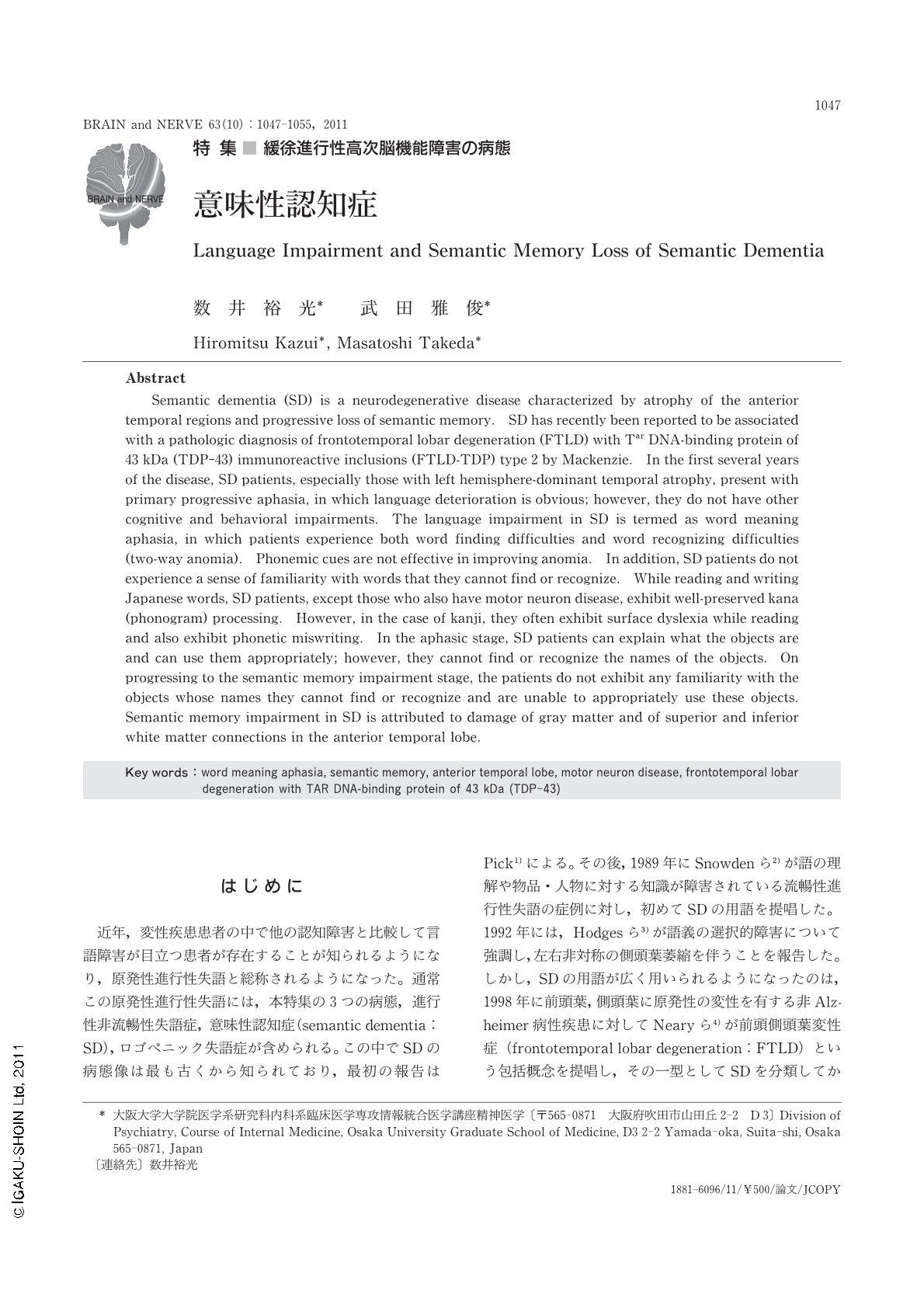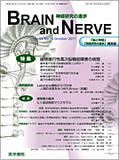Japanese
English
- 有料閲覧
- Abstract 文献概要
- 1ページ目 Look Inside
- 参考文献 Reference
はじめに
近年,変性疾患患者の中で他の認知障害と比較して言語障害が目立つ患者が存在することが知られるようになり,原発性進行性失語と総称されるようになった。通常この原発性進行性失語には,本特集の3つの病態,進行性非流暢性失語症,意味性認知症(semantic dementia:SD),ロゴペニック失語症が含められる。この中でSDの病態像は最も古くから知られており,最初の報告はPick1)による。その後,1989年にSnowdenら2)が語の理解や物品・人物に対する知識が障害されている流暢性進行性失語の症例に対し,初めてSDの用語を提唱した。1992年には,Hodgesら3)が語義の選択的障害について強調し,左右非対称の側頭葉萎縮を伴うことを報告した。しかし,SDの用語が広く用いられるようになったのは,1998年に前頭葉,側頭葉に原発性の変性を有する非Alzheimer病性疾患に対してNearyら4)が前頭側頭葉変性症(frontotemporal lobar degeneration:FTLD)という包括概念を提唱し,その一型としてSDを分類してからである。近年,SDに対する症候学的研究に加え,神経画像学的研究,分子生物学的研究が精力的になされ,SDの病態解明が進んできた。本稿では診断に役立つ臨床症状や検査所見の解説に加え,最新の研究で明らかになった知見を紹介する。
Abstract
Semantic dementia (SD) is a neurodegenerative disease characterized by atrophy of the anterior temporal regions and progressive loss of semantic memory. SD has recently been reported to be associated with a pathologic diagnosis of frontotemporal lobar degeneration (FTLD) with Tar DNA-binding protein of 43 kDa (TDP-43) immunoreactive inclusions (FTLD-TDP) type 2 by Mackenzie. In the first several years of the disease,SD patients,especially those with left hemisphere-dominant temporal atrophy,present with primary progressive aphasia,in which language deterioration is obvious; however,they do not have other cognitive and behavioral impairments. The language impairment in SD is termed as word meaning aphasia,in which patients experience both word finding difficulties and word recognizing difficulties (two-way anomia). Phonemic cues are not effective in improving anomia. In addition,SD patients do not experience a sense of familiarity with words that they cannot find or recognize. While reading and writing Japanese words,SD patients,except those who also have motor neuron disease,exhibit well-preserved kana (phonogram) processing. However,in the case of kanji,they often exhibit surface dyslexia while reading and also exhibit phonetic miswriting. In the aphasic stage,SD patients can explain what the objects are and can use them appropriately; however,they cannot find or recognize the names of the objects. On progressing to the semantic memory impairment stage,the patients do not exhibit any familiarity with the objects whose names they cannot find or recognize and are unable to appropriately use these objects. Semantic memory impairment in SD is attributed to damage of gray matter and of superior and inferior white matter connections in the anterior temporal lobe.

Copyright © 2011, Igaku-Shoin Ltd. All rights reserved.


